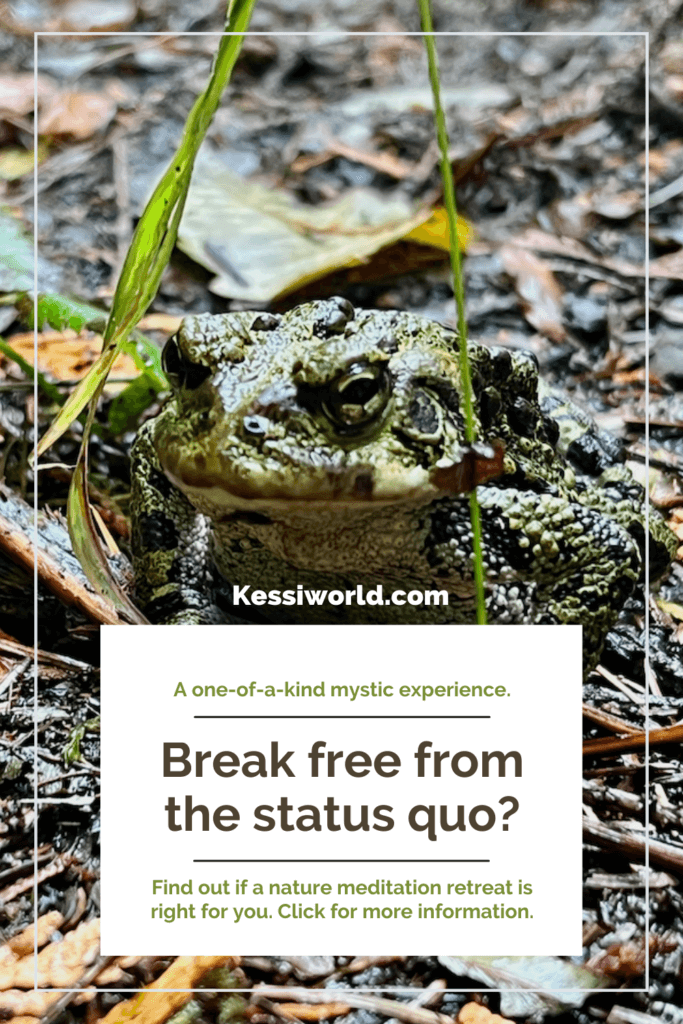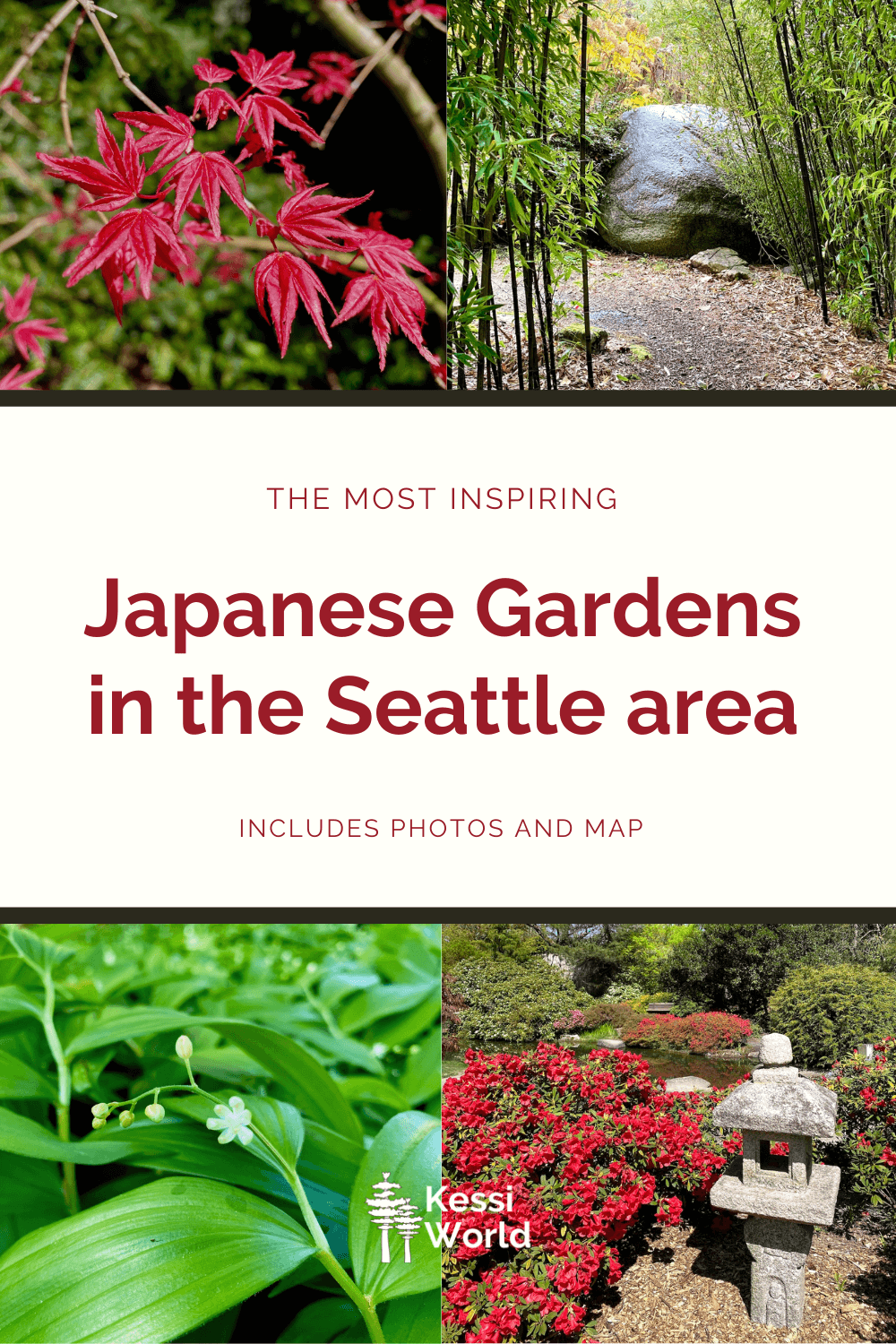
Nothing seems to bring together the delicate balance between the serenity of nature and human touch better than a Japanese style garden. The history of the Pacific Northwest is rich with connections between Japan and Washington State — two parts of the world steeped in an abundant variety of scenery where rich textures and colors contrast, any season of the year. Japanese culture has been around the Emerald City for over a hundred years, and inspired the creation of spectacular Japanese gardens in Seattle since that time.
This article brings to life my 9 favorite Japanese inspired gardens in the Seattle area
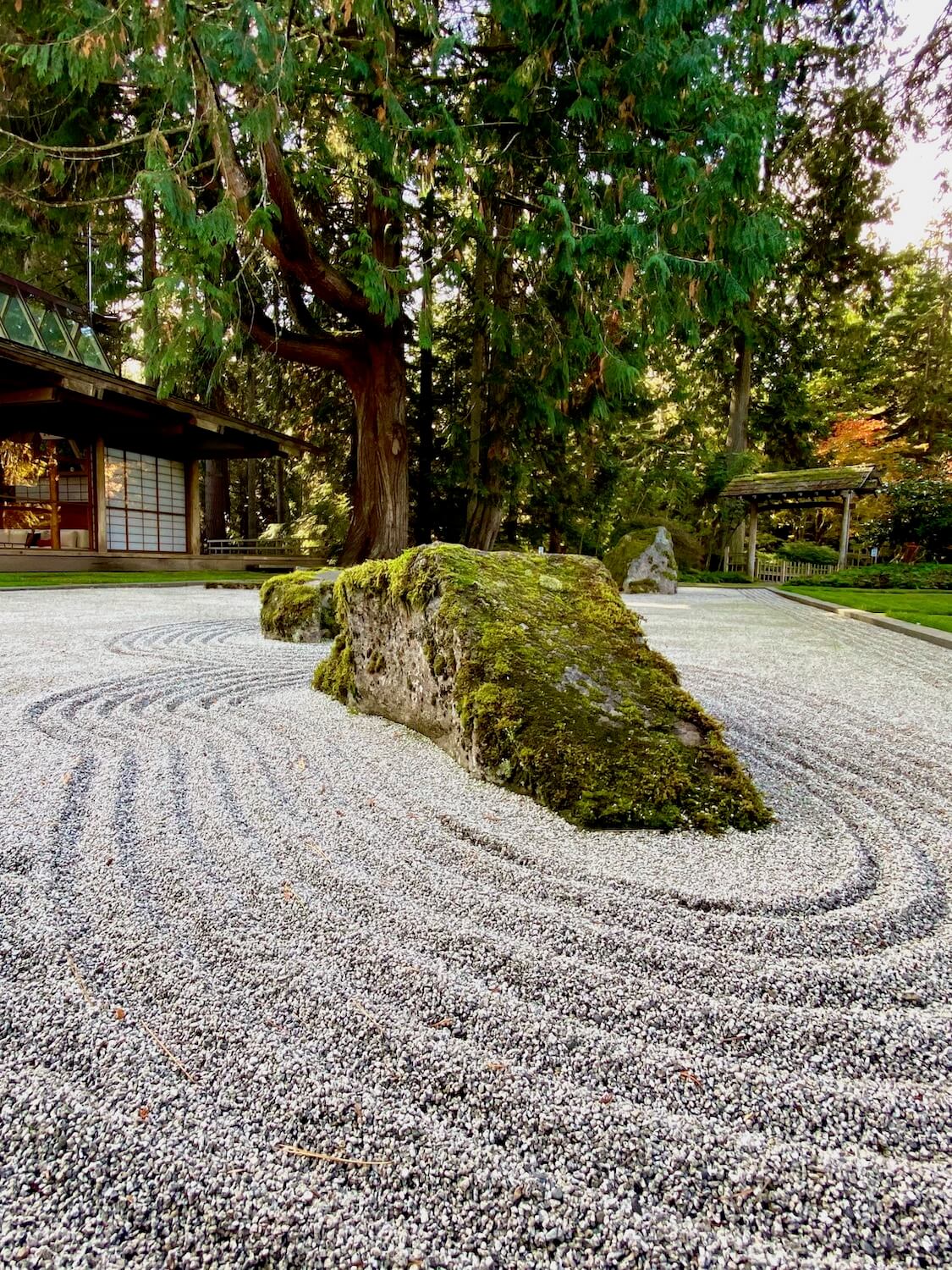
Table of Contents
- Map of Japanese gardens in the Seattle area
- Seattle Japanese Garden
- Japanese guest house and Zen garden at the Bloedel Reserve
- Kubota Garden
- Yao Garden at Bellevue Botanical Garden
- Seike Japanese Garden at Highline SeaTac Botanical Garden
- Japanese Garden at Point Defiance Park
- UPS Waterfall Garden Park — tiny Japanese garden in Seattle
- Japanese Tea Garden — at Seattle University
- Kruckeberg Botanic Garden
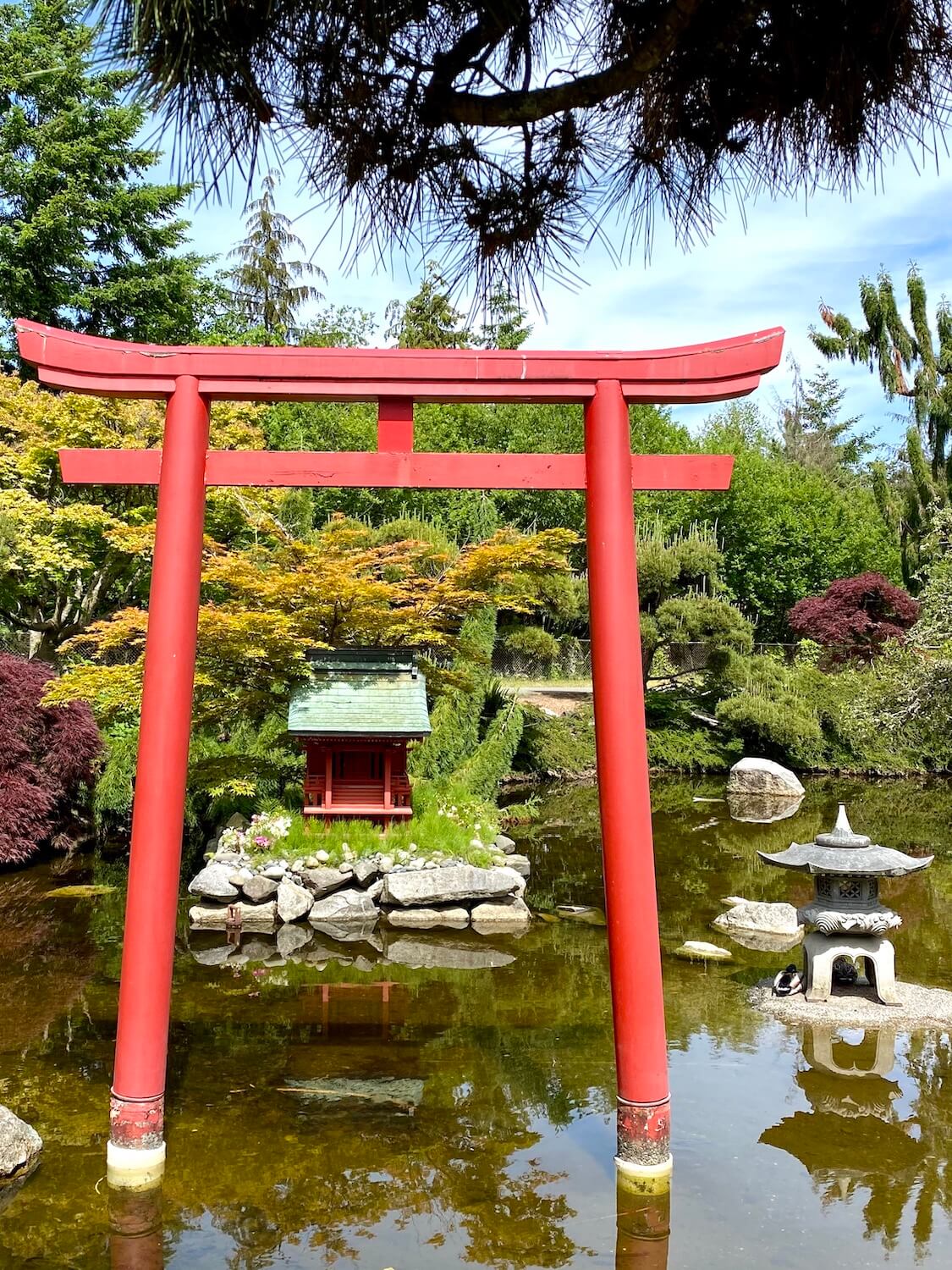
I grew up on a farm in Oregon and had an early fascination with the aviation world. I’d often gaze up into the sky from the hay fields, wondering where the planes above were headed. One day, Delta Air Lines announced nonstop service between Portland and Tokyo with a full-page newspaper advertisement in the local paper. The pitch featured a colorful Japanese garden with a moon bridge over a serene pool of water and I was enamored with the exotic and peaceful way it all seemed to flow together. I asked my mom to take me to the Portland Japanese Garden (among the best in the world) and although I really wanted to run through the Zen rock garden, my spirit immediately connected with the blissful balance of nature.
Map of Japanese inspired gardens in the Seattle area
Since that time, I’ve been to Japan and elsewhere in East Asia on many occasions. In fact, I wrote about my learnings with “The Way” of Taoism in a recent blog post. While I love the hustle and bustle of the busy streets — full of lively food vendors and make-shift shops — my heart usually zeros right in on the parks and gardens and aspect of nature that value quietude and connecting with the environment. You see, the busy chaotic scenes are only sustainable with a release valve of sorts, which I see as inspiring gardens.
Seattle Japanese Garden

A formal garden amidst the abundantly beautiful Washington Arboretum, this well curated patch is the iconic Seattle Japanese Garden. I love strolling the intricately crafted paths among the 3.2 acre organic inspiration any time of year — although the park is closed for several months in the Winter for routine maintenance.
The tranquil space is designed to offer all the traditional elements of a Japanese garden. Winding paths through the lowlands, water features, ornate bridges and stones leading up to mountain-like perches all come together to carry the soul through this peaceful experience. Of all the inspiring Japanese gardens in Seattle, this one offers the best opportunities to witness wildlife — turtles, colorful koy and different varieties of birds all find home here.
My favorite viewpoint is on the West end of the space, where the hill begins to gain elevation. The pagoda under a grove of cedars offers protection from the elements and the feeling of seclusion, even as other guests stroll the pea gravel paths below. Since the Washington Park Arboretum surrounds this space, the view offers nothing but uninterrupted natural beauty.
The garden opens March 6, 2021 and while walk-up tickets are available Tuesday through Thursday, advanced reservations are required Friday through Sunday. The gardens are closed on Monday. At the time of this writing (March 2021), adult tickets are $8 (locals get a discounted price), youth/seniors $4 and children 0-5 are free.
Japanese guest house and Zen garden at the Bloedel Reserve
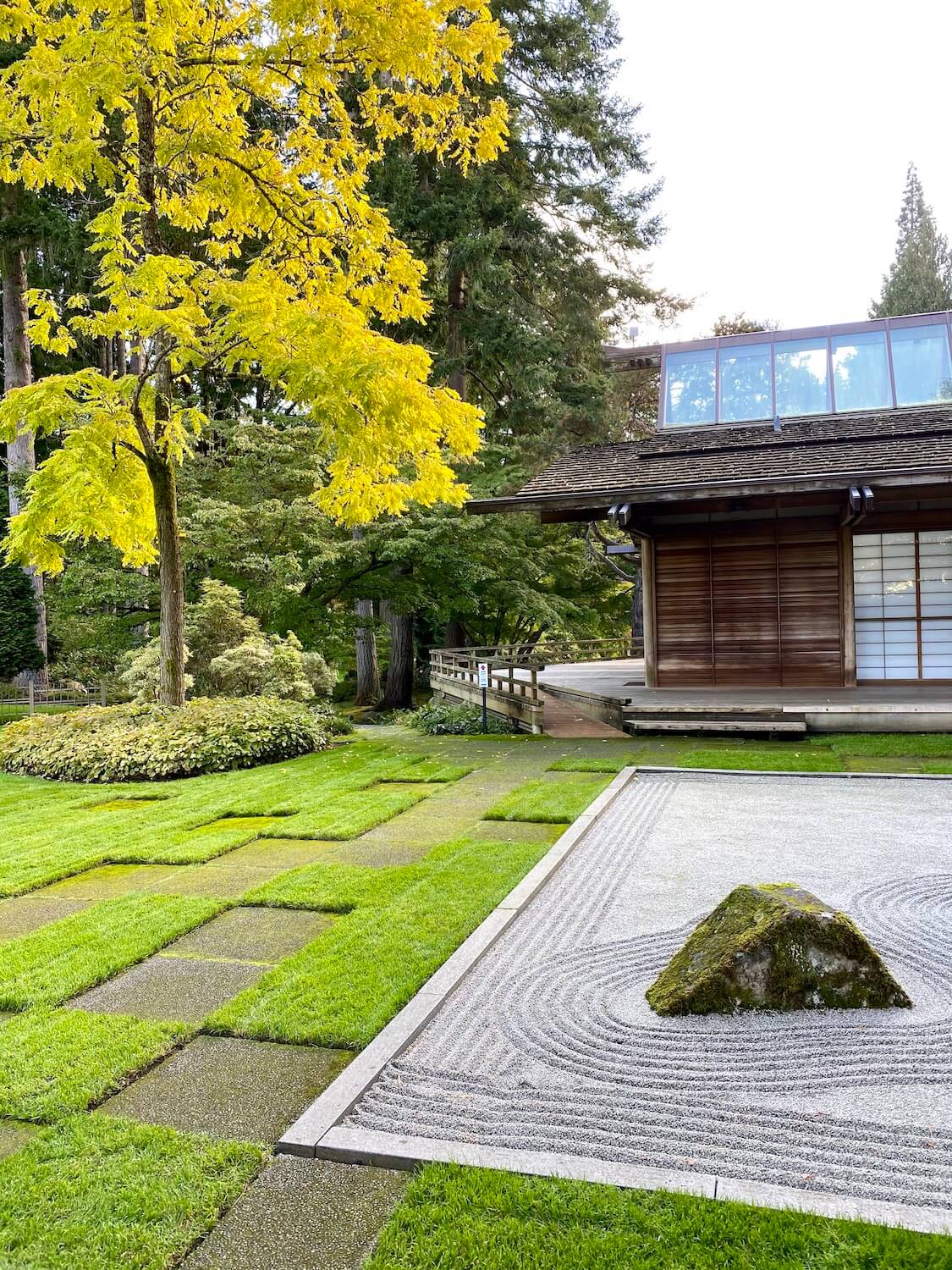
Bainbridge Island makes a fabulous day trip from Seattle, offering an alchemy of the open waters enjoyed on the Washington State Ferry system, island charm, and the commanding inspiration of nature in places such as the Bloedel Reserve. I enjoy this space so much I became a member, and although the system to reserve a specific time to enter the 150-acre oasis of nature can feel a little fussy at first, the experience is well worth the effort.
The guest house was created to offer guests on the estate a private area, as well as a place for entertaining. The architecture was commissioned to combine traditional Japanese features with the local Native American long house design in a way that offers peaceful geometric lines supporting large spacial areas of glass.
Although the map offered at the beginning of the Bloedel experience suggests a wide two-mile loop, it’s possible to simply walk down the paved roadway toward the moss garden and turn left. Enter the gate into the meticulously groomed gravel Zen garden and have a stroll. Be sure to walk around the outer decking to rest on one of the benches and take in the sweeping view of organic balance between rock, earth, plants and water.
Check the Bloedel Reserve website for specific operating details, but in general the estate is open to the public Tuesday through Sunday year-round, rain or shine. Entrance is timed and tickets can be purchased online — prices start at $17 for adults down to free for the 0-4 year old crowd. I suggest trying to arrive as close to 10AM (the opening time) as possible to avoid crowds, especially on the weekends.
Kubota Garden

Fujitaro Kubota arrived in the US from Japan in 1907 and created an inspiring legacy throughout his 94 years living in South Seattle. A business owner and nature enthusiast, his mission was to display the beauty of the Pacific Northwest in a distinctly Japanese way. This stunning park started as five acres of personal home and gardens and endured several iterations over the years to become as large as 20 acres and then reduced down again as the expanding city developed. Today the expanse of natural elements is operated by the City of Seattle Parks and open to the public year-round.
A calm quickly surrounds visitors when walking through the Japanese entryway and soon enough decisions must be made about which way to explore. Similar to most gardens of this style, zones represent the different elements of Japan — lowland lakes to rock covered mountains. A feeling of space abounds and it’s easy to get lost in thickets of bamboo. Pursue the gentle sounds of water rolling off grand pieces of slate — waterfalls and streams seem to be everywhere. Follow the stepping stones through the thicket to the crest of a knoll and view the sweeping landscape from atop a water fountain.
Spring is a great time to visit, as magnolias, azaleas and cherry blossoms are in bloom and the bright colors of emerging leaves from the many varieties of Japanese Maples create a collage of vibrant energy. There are picnic tables, several formal terrace viewpoints and a variety of sweeping lawns to spend time relaxing in this lovingly crafted botanical space.
Yao Garden at Bellevue Botanical Garden
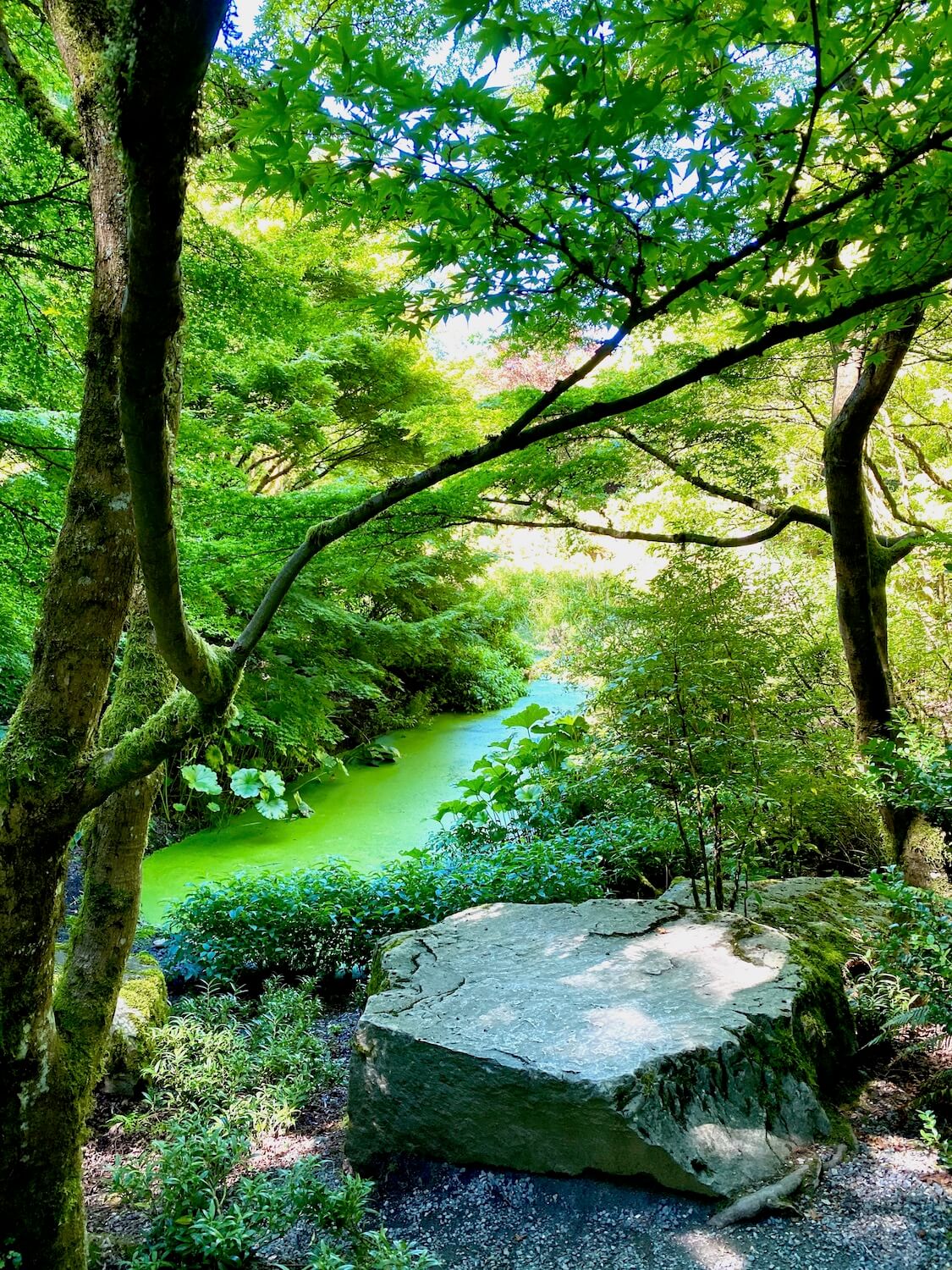
Bellevue Botanical Garden offers surprise and delight for visitors no matter the time of year. The experience is so delightful I also include this beauty in another article, Seattle botanical gardens — the 10 best kept local secrets. The garden has a number of zones, including a fantastic suspension bridge in what they call the ravine experience, and not to be missed is the Japanese-inspired Yao Garden.
The garden prides itself on providing a masterful example of fusion between traditional Japanese elements of a strolling garden with the diversity and beauty of Pacific Northwest favorites — weaving together a patchwork of tranquility that is a favorite of mine in any season.
The gardens are free to enter and there usually seems to be plenty of parking available on the premises. Check out Copper Kettle Coffee Bar, which is located in a cool mid-century home turned architectural feature on the high point of the garden. In addition to all the usual coffee drinks, they serve up Sweet Alchemy ice cream and a few yummy plant based entrees and friendly attitudes.
Seike Japanese Garden at Highline SeaTac Botanical Garden

Of all the gardens on this list, this space feels the most inspirational. Perhaps because the balance of rock and mature red and black pine trees were lovingly relocated in their entirety in 2002 from a family plot of land that now sits under the third runway at SeaTac International Airport. In fact, the back story is full of passion for Japanese heritage, overcoming adversity, all within a perfect balance of nature.
The ornate garden was the dream of Shinichi Seike, who immigrated from a southern Japanese island in 1919 and settled on 13 acres of land in the Highline community (which is adjacent to Seatac Airport) with his wife and 5 kids. In 1942 they were required to relocate to internment camps. While many Japanese American families lost their assets during the internment, the Seikes were fortunate that a German-American family managed their property during their absence.
In post-war era, Mr. Seike started a nursery which was a family affair and the formal garden was started in 1961 as a memorial to Toll, one of the sons who fought and was killed in action during WWII in France. The garden sprung up in conjunction with the opening of the Seattle’s World Fair (1962) and was designed under the direction of Shintaro Okada, a garden designer from Hiroshima.

In 1996 Seatac Airport was up for expansion and the nursery and celebrated garden were in the immediate path of the slated new runway. Through a lengthy period of negotiation and acquisition of funding, the entire garden was dug up and relocated to the present setting at the Highline Seatac Botanical Garden. Every rock was gently dislodged and catalogued in an elaborate process that precisely recreated the iconic garden.
Today, walking over the classic Japanese garden bridges the Seike legacy is felt through and through. There are excellent examples of the three common bridge designs (Zigzag, Full-Moon and Earth) as well as lanterns (Pedestal, Snow-viewing and buried). The rest of the botanical garden is relatively young (started in 1999) and continues to grow and expand with each season. Regardless, the feeling of love that comes from natural balance and the energy of the Seike Japanese Garden invites inspiration any time of year.
Japanese Garden at Point Defiance Park
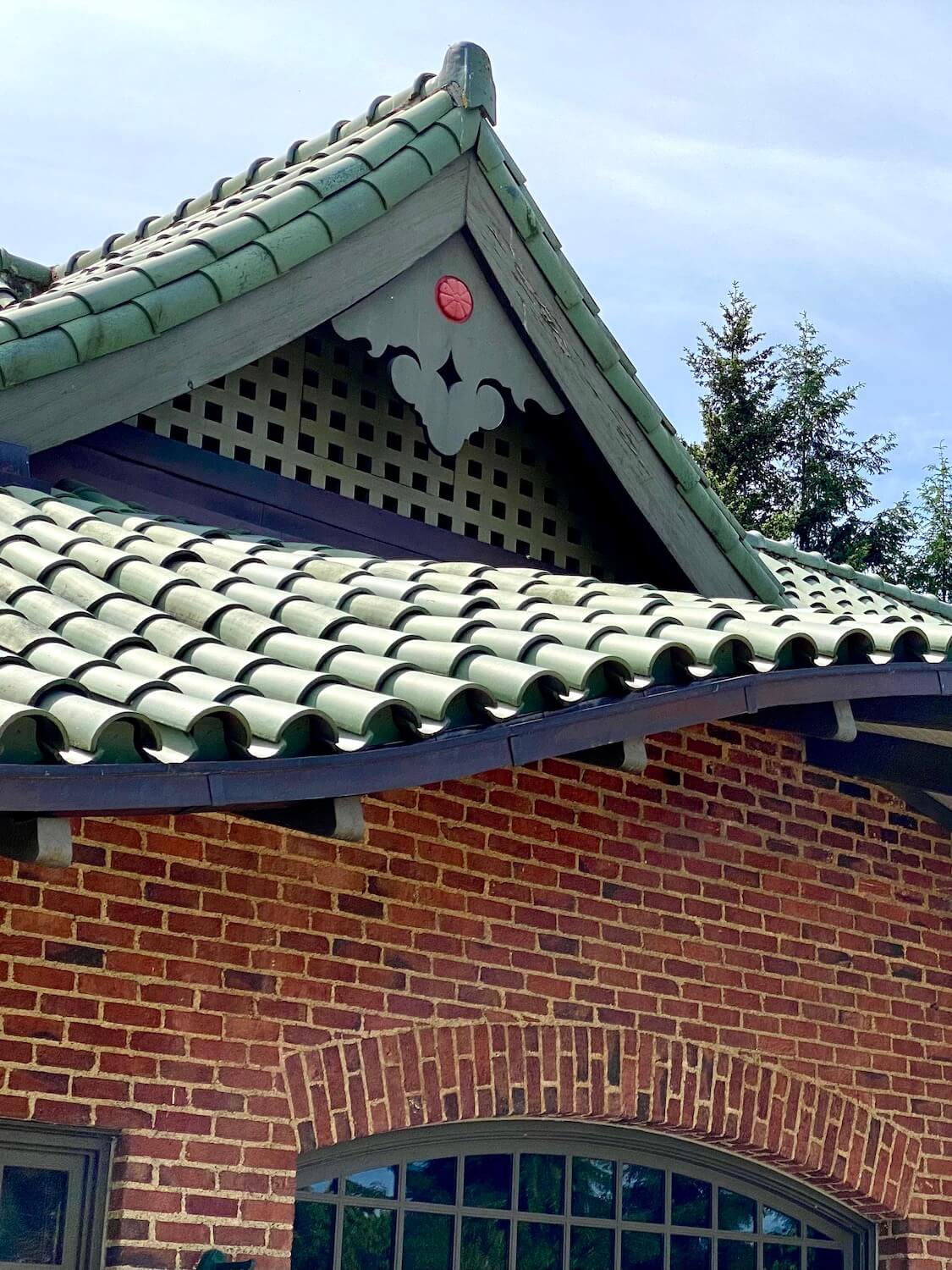
Point Defiance Park, in Tacoma, Washington is a fantastic enclave exhibiting the balance of nature preserved. There is a world class zoo, beaches and hiking trails that wind through old growth cedar and douglas fir and dense thickets of rhododendron. My mom grew up literally across the street from this park, so I have many wonderful memories of exploring this space. On our family walks we’d always make it a point to stroll through the Japanese Garden.
The intricate red bricks topped by jade tiles create a formal tea house perched atop a large bluff leading down to the Point Defiance ferry to Talequah (Vashon Island). I love the bright red gate situated within the koy pond and the buds that swing into full bloom in Spring when the azaleas, rhododendron and cherry blossoms burst onto the scene.
The garden is free and open year-round. There are a lot of other things to explore in this area, making the Japanese Garden at Point Defiance Park a great option for a day trip from Seattle or other part of the Salish Sea area.
UPS Waterfall Garden Park — tiny Japanese garden in Seattle
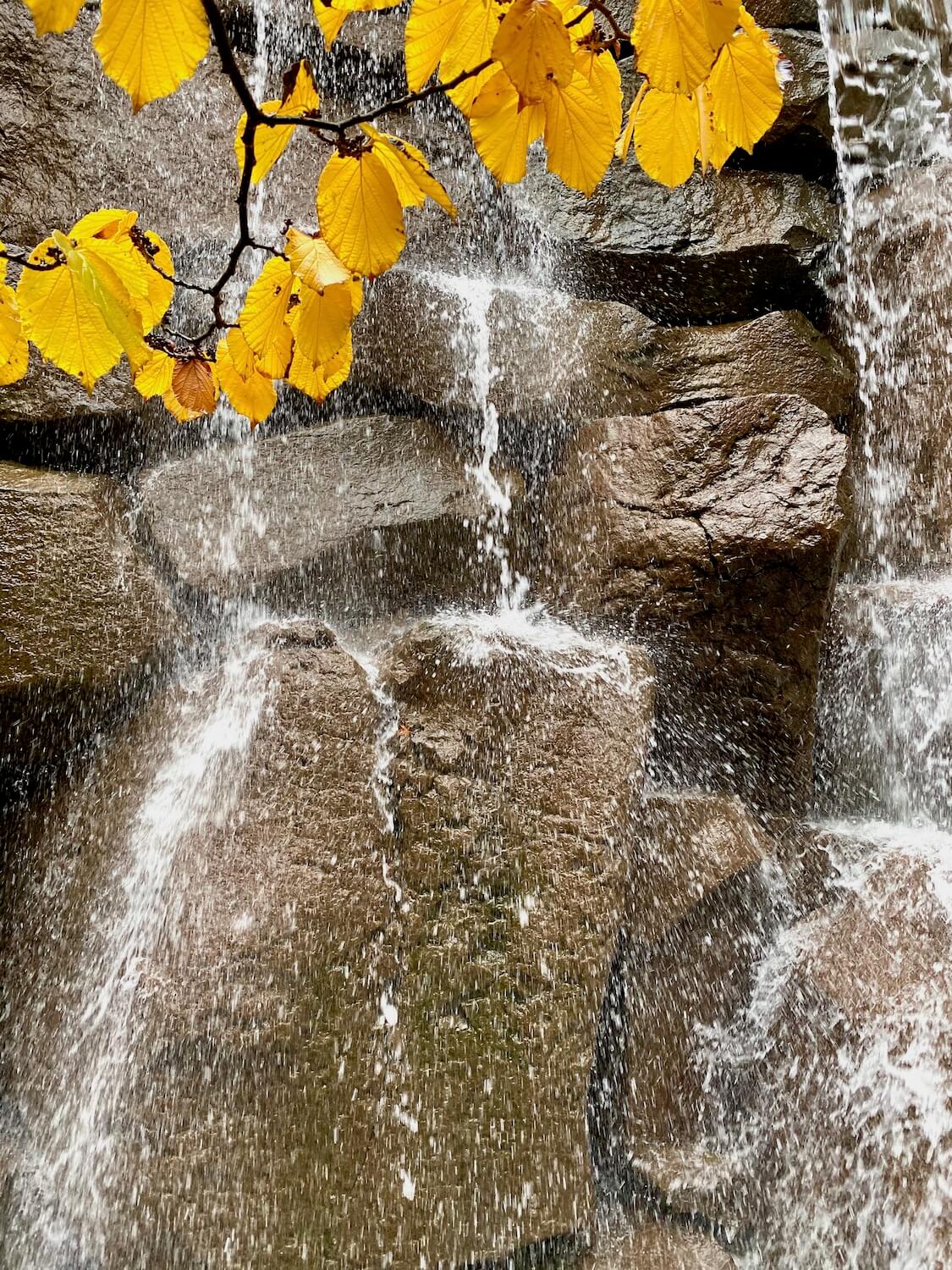
This tiny little park is in the urban heart of Downtown Seattle and commemorates the location of the first UPS building. The pool and Japanese Garden were designed by Japanese landscape architect Yoshikuni Araki and although simple and tiny, contain a number of botanicals native to Japan. The pounding flow of water down a dramatic wall of rock seems to be an enticing location for office workers to enjoy an outdoor lunch. The location near Occidental Park in the Pioneer Square area makes it central to many food and drink options there, and within a few block’s walk to Seattle’s Chinatown.
The park is free and open between 8am and 5:30pm.
Japanese Tea Garden — at Seattle University
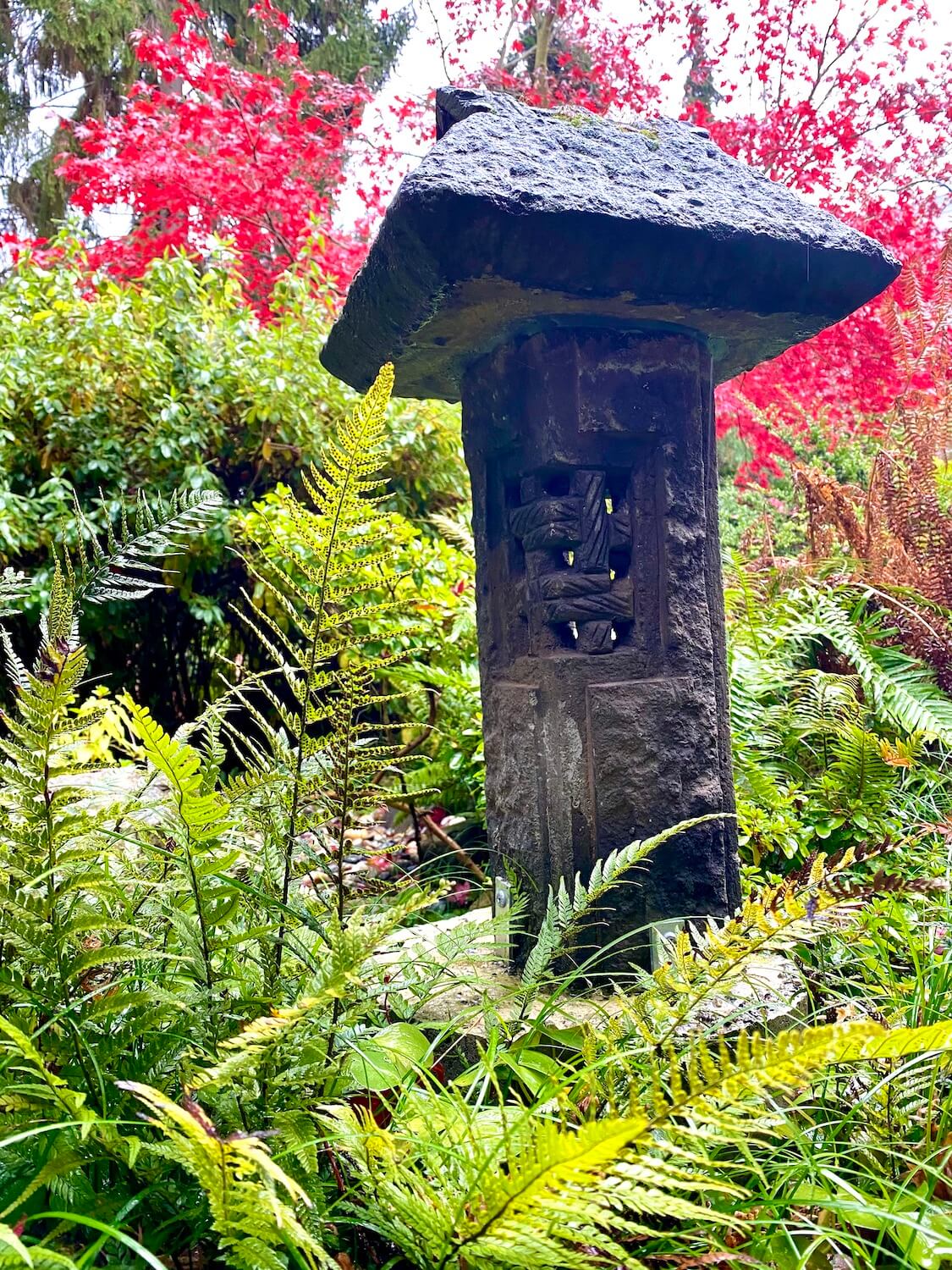
This simple, understated park on the beautiful grounds of Seattle University provides the perfect sanctuary from the buzz of hospitals and other action nearby on Capitol Hill. The location is not well marked and although tucked away South of Cherry Street, worth discovery.
Kruckeberg Botanic Garden
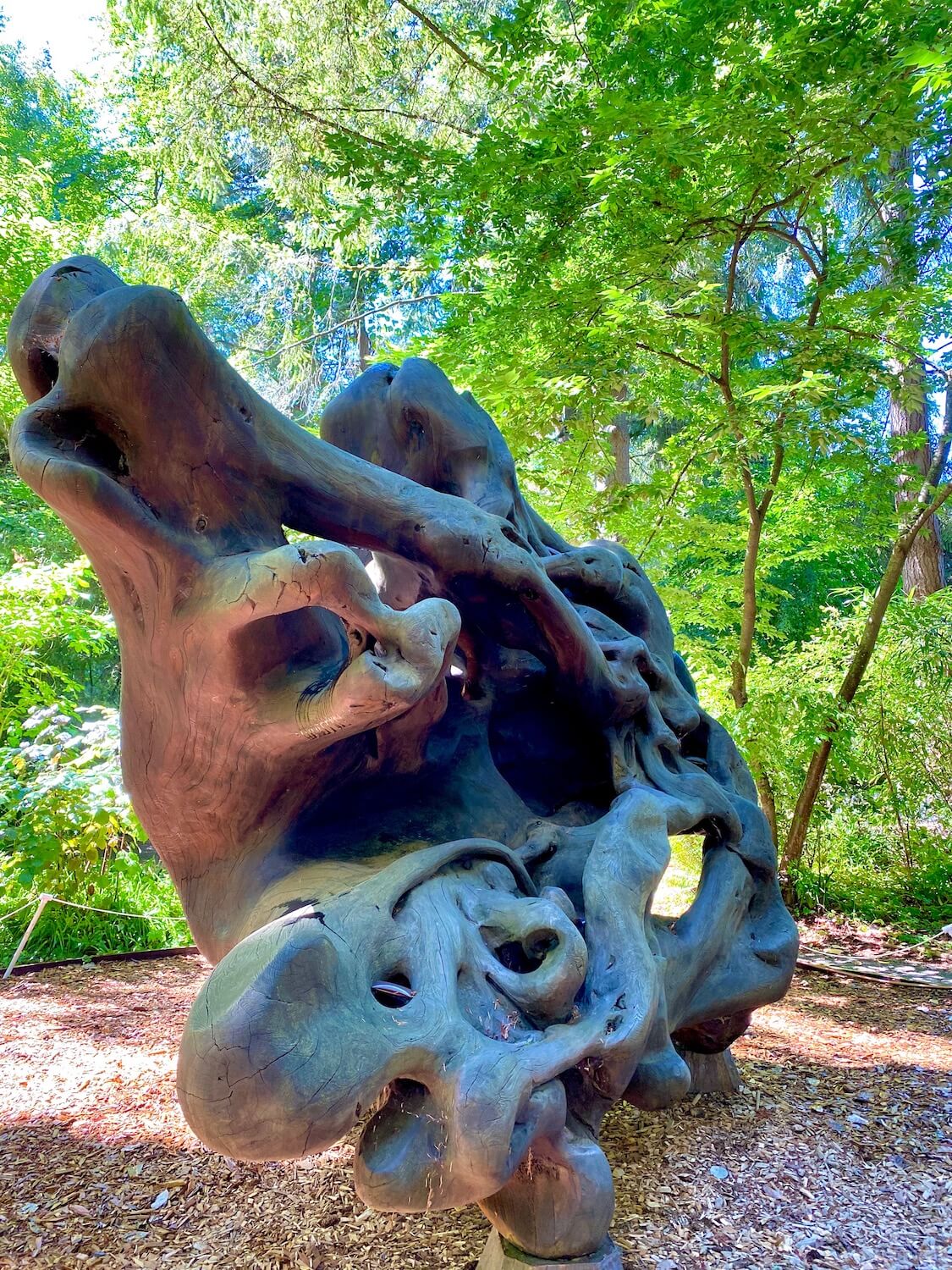
Kruckeberg is located in Shoreline, a northern suburb of Seattle within a stone’s throw to a few other great parks overlooking the Salish Sea. While not a formal Japanese Garden, I appreciate the various nods to Asian-inspired botany that include a number of species indigenous to Japan. I feature this subtle gem in another article about the best kept secrets of Botanical Gardens in Seattle, and the fascinating story of Dr. Art and Mareen Kruckeberg, who traveled all over the world to gather plant matter, seems apropos to inclusion in my list of inspiring Asian themed gardens in Seattle.
Look for the Champion trees amongst paths that wind down a wooded hill filled with ferns, azaleas, rhododendron and even a whimsical sculpture carved from the root system of a 1000-year old redwood (shown above), partially hidden in a grove of exotic varieties of fir. The park is free but they do suggest donations, so take some cash to put in the box. MsK Nursery, hard to miss at the entrance to the garden, is a great place to buy unique and well-loved plants to take home.
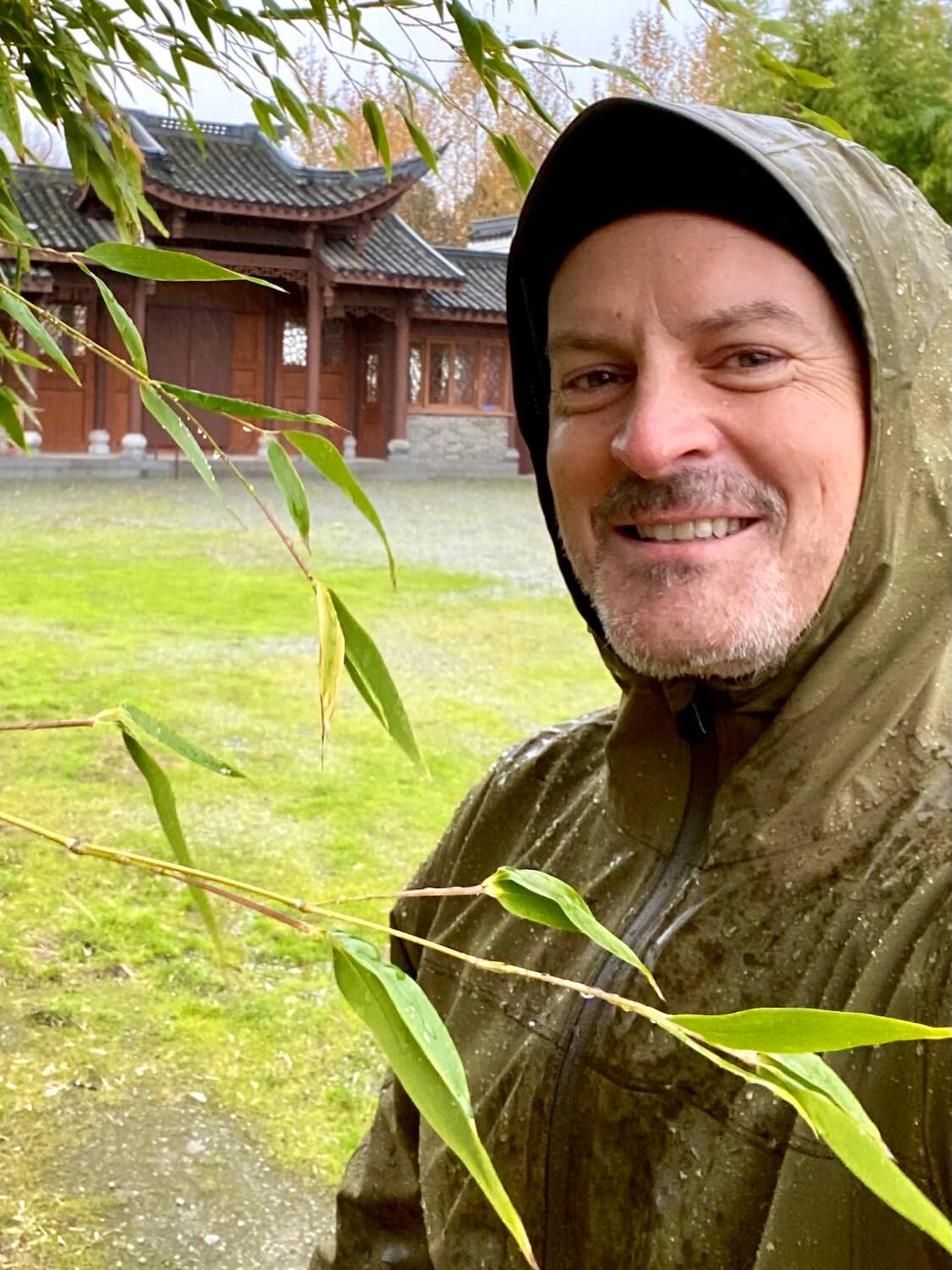
Pacific Bonsai Museum
Tucked away amongst a fir forest in Federal Way, Washington, and about 30 minutes from Seattle, the Pacific Bonsai Museum is features over 60 miniature trees. Although this isn’t a garden per-se, I felt inspired to write a separate article about this beautiful exhibit. Click on the Pinterest pin below or here to get more information.
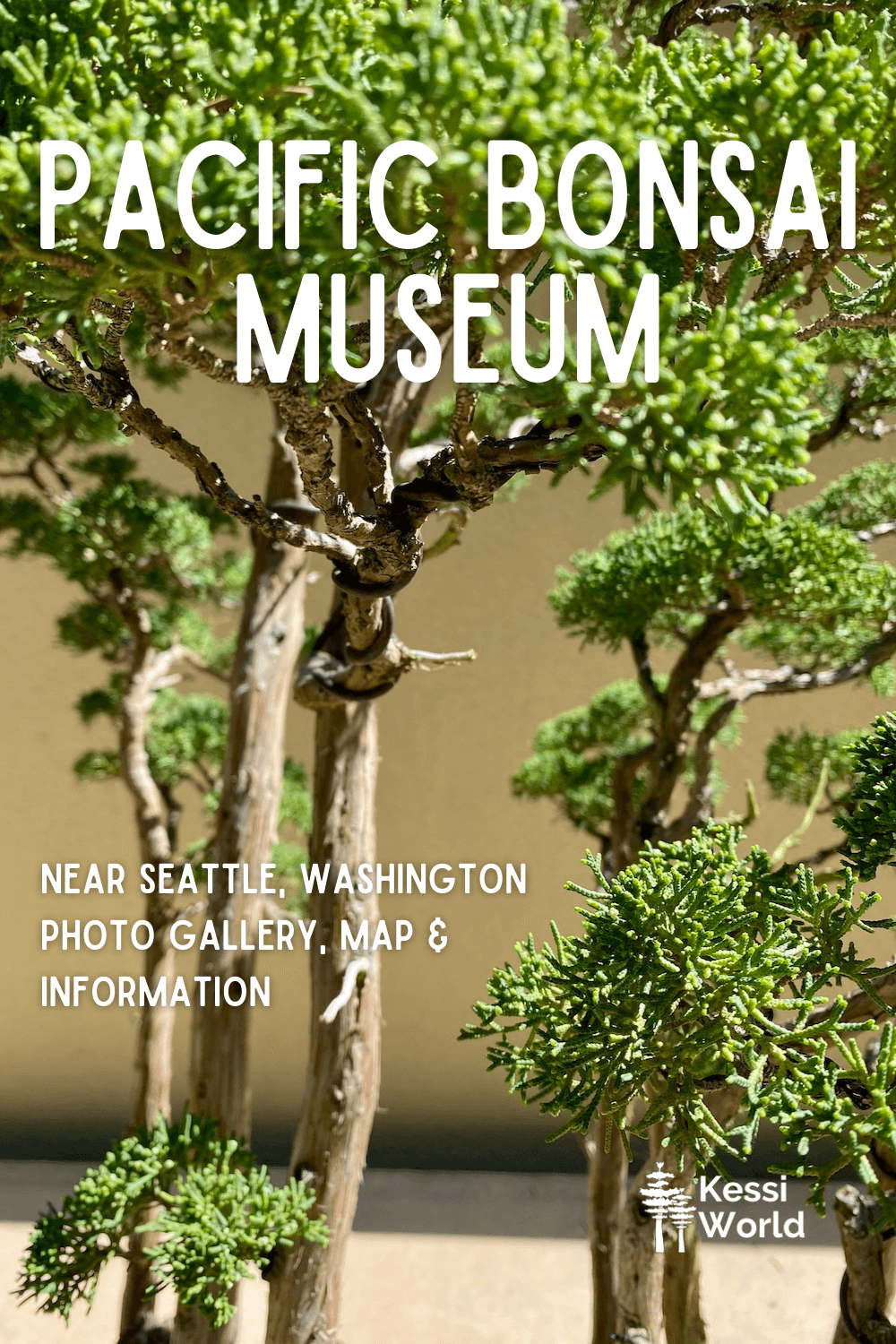
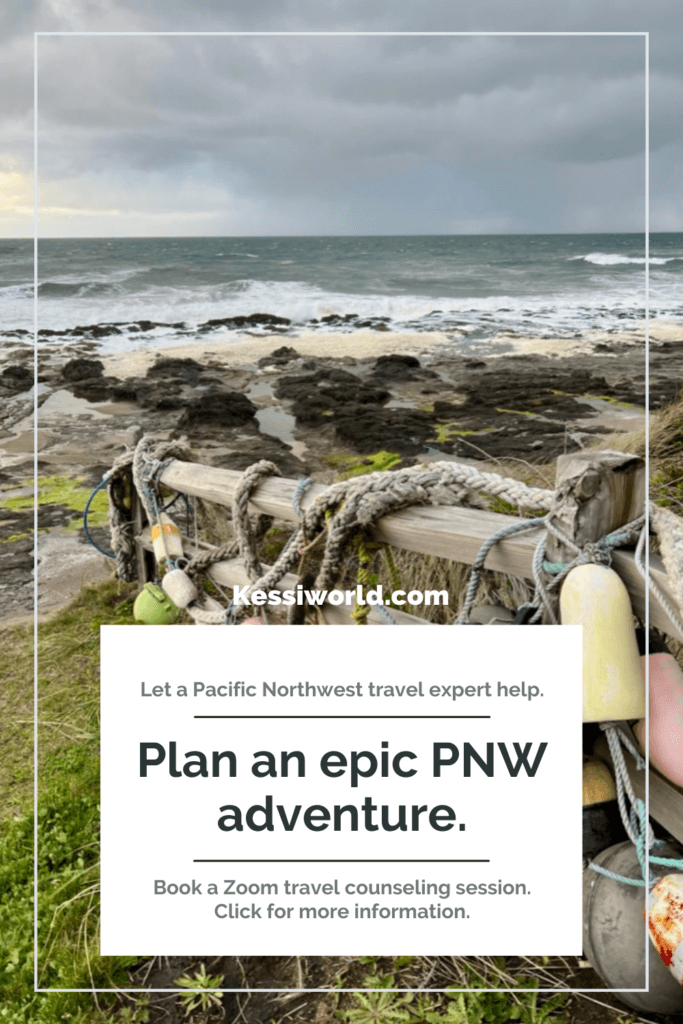
Travel the Pacific Northwest with purpose and meaning.
A lifetime of wandering about Oregon and Washington State gives me powerful practical wisdom to share about travel. And you receive the bonus of my unique mystic connection to the land. I can show you how and where to deepen in nature. This is perfect for:
- First time visitors to the Pacific Northwest.
- Locals hosting out-of-town visitors.
- Those wanting to experience travel + nature + spirit in new ways.
Learn what impedes, supports, and transforms you through Nature Meditation.
Are you stuck in the hamster wheel of daily life, yearning for change but unsure where to start? Are life circumstances overwhelming you, leaving you feeling lost and anxious? Is there a background static of uncertainty holding you back? Welcome to a transformative nature immersion retreat and guided mindfulness experience that will empower you to see your wild nature. You will forever be changed.
